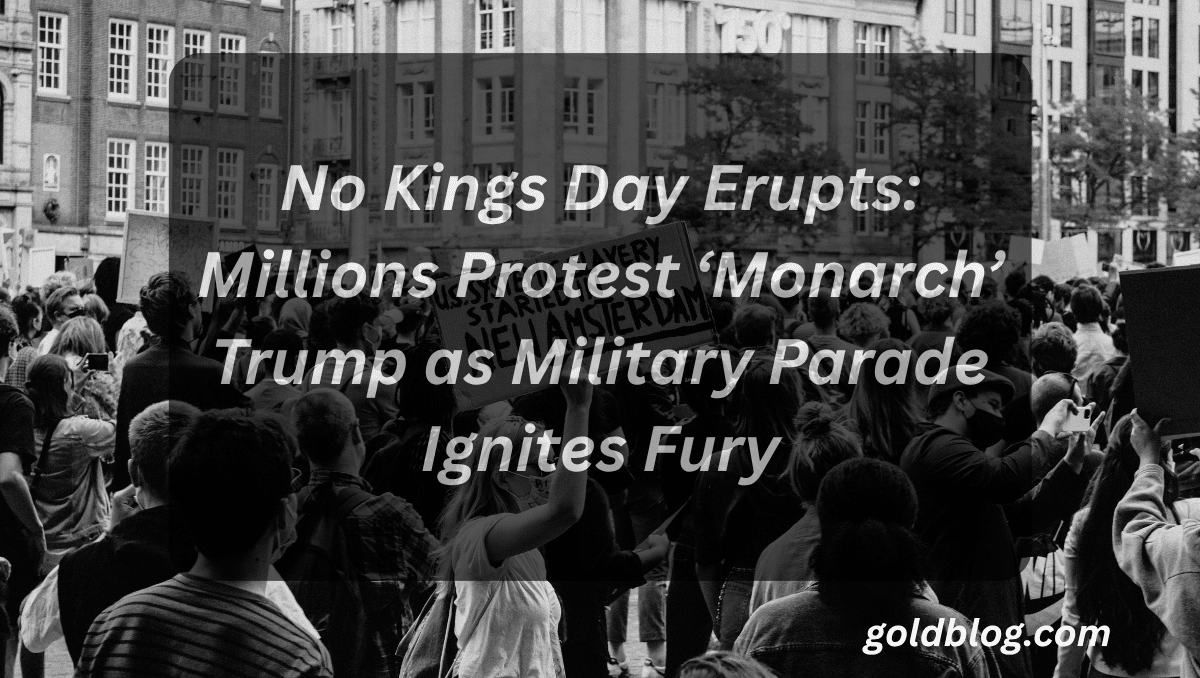On Saturday, June 14, 2025, cities across America—and even abroad—were ablaze with one unifying declaration: No Kings. From New York to San Diego, from Philadelphia to Salt Lake City, protesters rallied under banners denouncing perceived authoritarianism, billionaire politics, and the “militarization of democracy.” Here’s a deep dive into what the No Kings movement was, why it captured millions, and how June 14 became a modern flashpoint in America’s political and cultural identity.
What is the No Kings Protest? A National Day of Defiance
No Kings Day—also dubbed No Dictators Day—was organized by the grass‑roots 50501 Movement (meaning all 50 states, 50 events, one united message). Its aim? To push back against former President Trump’s second-term actions, including a high-profile military parade in Washington, D.C., his 79th birthday, sweeping immigration raids, and what demonstrators see as a drift toward centralized power.
The movement explicitly rejects the image of Trump as a king-like figure—criticizing the deployment of federal troops to Los Angeles, anti-ICE walkouts, and escalating rhetoric that protesters say threatens democratic checks and balances.
How Many Protested? A Sea of Voices Across the Nation
Organizers and independent analysts report:
- 2,000+ cities and towns participated nationwide.
- 5 to 6 million participants overall.
- City highlights:
- New York City: ~50,000 marchers.
- Philadelphia: ~80,000 strong, including civil rights icon Martin Luther King III .
- Chicago: ~75,000 protesters.
- San Diego: ~60,000 rallying in downtown.
- Los Angeles: Tens of thousands thronged City Hall and beyond.
- Denver: Multiple peaceful marches in parks and bridges .
Notable smaller communities also participated—from Manistee (~800 marchers) to Midland, MI (several thousand).
Why June 14? The Convergence of Power Displays
June 14 wasn’t picked by chance. It marked:
- Trump’s 79th birthday, celebrated alongside
- A military parade in D.C. commemorating the U.S. Army’s 250th century
The protesters viewed this as a symbol of military pomp replacing civil leadership, an alarming echo of royal pageantry they felt unfit for a democracy.
Why Are People Protesting? A Coalition of Causes
No Kings encapsulates multiple concerns:
- Authoritarian drift: Deploying troops domestically, issuing mass deportations, and eroding independent institutions .
- Immigration enforcement: ICE raids sparked backlash—especially in border and sanctuary cities.
- Civil liberties: The use of tear gas, curfews in L.A., and recent politically-motivated violence (including shootings in Minnesota) alarmed freedom advocates.
- Broad democratic values: Protecting free speech, upholding constitutional checks, opposing billionaire influence, and repudiating “kingly” behavior.
Celebrities such as Mark Ruffalo, Susan Sarandon, and Kerry Washington spoke out—Ruffalo even referred to protesters as “the Avengers”, accentuating the urgency of collective action.
Highlights From Major Cities
New York City:
NYC drew ~50,000 protestors. Mark Ruffalo, channeling his Marvel fame, called attendees “Avengers of Democracy”, urging unity against what he termed a creeping authoritarianism. Notably, political figures marched alongside him .
Chicago:
An estimated 75,000 people marched past Trump Tower. Speakers warned against “gangster state” governance, emphasizing that power must remain with the people .
San Diego:
Approximately 60,000 rallied downtown in the largest protest the city has seen in years, voicing opposition to federal policies and police militarization .
Los Angeles:
Protests in L.A. echoed recent civil unrest around ICE. Over 25,000 assembled City Hall, but clashes and tear gas were used. Police enacted an 8 p.m. curfew.
Salt Lake City:
Roughly 10,000 marched near the federal building. Tragically, the rally was marred by a shooting that left one man critically injured. Police arrested a suspect and two others.
Denver:
Across dozen-plus sites statewide, thousands marched peacefully. A smaller group clashed with police at night near I‑25 freeway. Booths and community engagement activities brought protesters together.
Nationwide Picture: Unity in Protest
❶ Scale & Diversity
From coastal metropolises to rural townships, protesters of all ages and backgrounds took part—sometimes tens of thousands, sometimes just a few dozen. This was not a fringe movement; it was an unprecedented wave of civic energy .
❷ Mostly Peaceful, Some Violence
While the majority of marches were peaceful, a few cities—Los Angeles, Salt Lake City, Portland—saw clashes, tear gas, or arrests. Minnesota protests were paused after a separate politically‑motivated killing .
❸ Official Responses
Mayors and governors urged calm. L.A.’s mayor praised orderly protests in San Francisco. Some deployed the National Guard or Marines, which sparked criticism. Police emphasized law enforcement would respond to violence firmly, but protect peaceful demonstration.
What Does It All Mean? A Democracy in Motion
This rallying cry of “No Kings” signals a deep societal divide—one that sees symbols of centralized power and military entireties not as strength, but as threats. These were not just political positions, but deeply felt beliefs held by millions who view this moment as pivotal for preserving democratic norms.
At its core, the movement challenges a narrative that the U.S. is drifting toward a more autocratic model. Protesters rallied not only against executive action, but also against concentrated capital and institutional overreach.
June 14 may mark the most coordinated single-day protest against a presidency in living memory—a sign that democracy itself is being actively defended in civic squares, streets, and social media feeds.
Looking Ahead: Aftermath & Accountability
- Investigations are underway in Salt Lake City and Los Angeles after violent incidents.
- Policy shifts: Local leaders promise to monitor and reassess federal deployments of troops and federal agencies.
- Continued mobilization: Organizers hinted at more demonstrations, hearings, and grassroots drives to challenge policies and election narratives.
Final Takeaway
No Kings Day wasn’t just another protest—it was a powerful national resonance. More than five million voices across 2,000+ locations rising in unison against concentrated power, oppression, and authoritarian symbolism. It was loud, it was broad, and it wasn’t going away when the smoke cleared.
This day stamped an indelible moment in American history: one where the people, in overwhelming numbers, joined to tell their leaders—they will not be kings, and there are limits to power.
If democracy is a dialogue, June 14 became its loudest calling yet.
